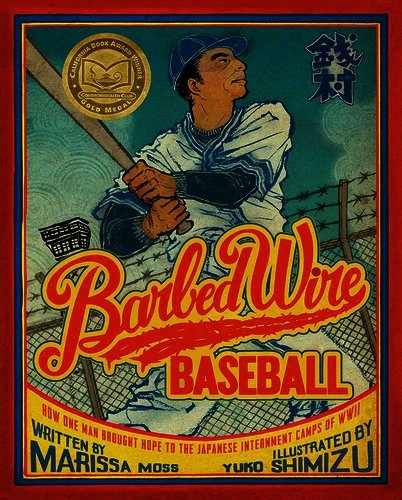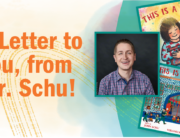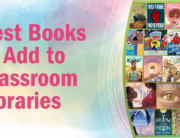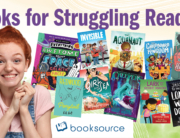Appropriate for a range of reading and interest levels, picture books like these can be used to introduce content-area lessons, to work a little more art and music into the school day, or to serve as entertaining read alouds.
For budding young scientists and mystery lovers:
Frog Song (Grades K-3)
(Grades K-3)
The illustrations in this book will be the first thing to grab readers. Who knew that frogs could be so beautiful? Each two-page spread introduces a different kind of frog and features lavishly detailed illustrations. The informative text presents interesting characteristics of each type of frog sure to interest kids, and the use of onomatopoeia makes this a fantastic choice for an informational read aloud. The back of the book contains more information and photographs of each frog discussed, as well as a long list of additional web resources for further study.
The Mystery Of Darwin’s Frog (Grades 2-5)
(Grades 2-5)
One of the more unusual frogs from Guiberson’s Frog Song is explored in depth in this picture book that tells the story of the strange frog discovered by Charles Darwin in 1834. Researchers were surprised to find one of Darwin’s male specimens packed with tadpoles, and this book follows the developments in research surrounding this unique species. This book is a great addition to the genre of narrative nonfiction, and turns scientific methods and discoveries into a story to be shared with students.
Lessons in history, sports, and cultural diversity:
World Rat Day: Poems About Real Holidays You’ve Never Heard Of  (Grades K-3)
(Grades K-3)
Lewis’s new poetry book introduces unusual holidays that will certainly spark discussions in class. There’s, of course, World Rat Day, but readers will also find such gems as Dragon Appreciation Day, Limerick Day, and International Cephalopod Awareness Day. Each holiday gets its own poem, featuring the fun and whimsical wordplay for which our Children’s Poet Laureate is known.
Barbed Wire Baseball (Grades 1-5)
(Grades 1-5)
This picture book biography explores the life of Kenichi “Zeni” Zenimura, the father of Japanese American baseball. At eight years old, Zeni moved with his family from Japan to Hawaii, where he was first introduced to baseball. Zeni became a talented player, playing in exhibition games in Japan and with star members of the New York Yankees. As this biography highlights, it was Zeni’s love of baseball that carried him through challenging times in World War II internment camps. The back of this book features two bibliographies—one from the author and one from illustrator Yuko Shimizu—leading readers to books, periodicals, websites, and multimedia sources for further study.
For artists, dancers, and musicians:
 The author-illustrator team that created A River Of Words: The Story Of William Carlos Williams, brings us a new picture book biography about self-taught African American artist Horace Pippin. Pippin’s experience fighting in the trenches of World War I left him with emotional and physical injuries that he worked through using his art as therapy. This uplifting book features the vibrant and colorful artwork expected of illustrator Melissa Sweet and makes good use of direct quotes from Pippin throughout. The back of the book includes extensive historical, author, and illustrator notes, as well as a list of websites and sources.
The author-illustrator team that created A River Of Words: The Story Of William Carlos Williams, brings us a new picture book biography about self-taught African American artist Horace Pippin. Pippin’s experience fighting in the trenches of World War I left him with emotional and physical injuries that he worked through using his art as therapy. This uplifting book features the vibrant and colorful artwork expected of illustrator Melissa Sweet and makes good use of direct quotes from Pippin throughout. The back of the book includes extensive historical, author, and illustrator notes, as well as a list of websites and sources.
The Beatles Were Fab (And They Were Funny) (Grades 1-4)
(Grades 1-4)
This picture book biography of the Beatles serves as an easy first introduction to the famous music group that had such a tremendous cultural impact. The authors cover the time period from the founding of the group through the end of Beatlemania. This would be fun to pair with study of some of the song lyrics, having students listen to the music and perhaps even watching some footage of the public response to the group during the height of Beatlemania.
When Stravinsky Met Nijinsky: Two Artists, their Ballet, And One Extraordinary Riot (Grades P-3)
(Grades P-3)
Beautiful illustrations and simple text lend themselves well to a read aloud in this picture book about an artistic collaboration that rocked the Parisian art world and gave birth to modern music and dance. It will be difficult for students to imagine the world of Paris in 1913 where audiences were so steeped in more traditional ballets, that the first performance of The Rite of Spring could cause a riot. For a strong Common Core lesson featuring music and art, this book could be combined with video recordings of The Rite of Spring and compared to video of the traditional style of ballet in Swan Lake. The descriptive language in this text also lends itself well to conversations about writing craft and visualizing the movements of dance and music that are difficult to depict with words and pictures.







Leave A Comment